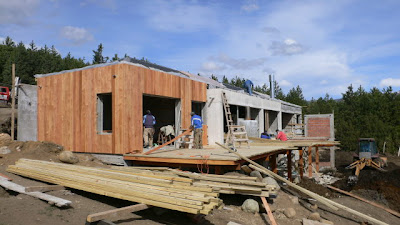
Loosely defined Patagonia is a sparsely populated region stretching sea to sea across the South American Continent south from the 40th parallel to Cape Horn at the tip of South America. It has a land area of 348,000 square miles/561,300 square kilometers, the equivalent size of the states of California and Montana combined (the U.S.’s 3rd and 4th largest states), but with a population of only 2,000,000 inhabitants. Blessed with natural resources of gas, oil, coal, and bauxite, extraction operations have fueled the region’s recent development. Previously sheep and cattle ranching and timber were the staples of its meager economy.

While Patagonia has been romanticized as a mysterious land, filled with wide open ranges, snow-capped mountains, smoldering volcanoes, trout-filled rivers and lakes, rugged gauchos and bank robbers like Butch Cassidy and the Sun Dance Kid, it is in fact all of that and more, except the bank robbers have moved to Bolivia. It is also filled with warmhearted people, the best beef in the world and has a mercurial climate of extremes. The rainforests of Chile receive more than 180”/450 cm of rain per year as the lofty Andes peaks wring the moisture from ocean- spawned clouds. To the east the arid Argentine steppes receive less than 15” annual rainfall. Dead still days give way in a matter of minutes to strong winds that can blow ferociously for days on end.

Nomadic Pre-Hispanic tribes settled in the region more than 10,000 years ago. Fernando Magellan made the first contact with the indigenous people in 1502. Disease, displacement, and genocide depopulated the region much the same way as in the American West. The vast steppes produced cattle and sheep barons from the 1850s on all contributing to Argentina’s rise as the world’s fifth wealthiest nation just prior to World War II hostilities. Post War political and economic upheavals and the collapse of the railroads under Dictator Juan Perón in the 1950s left the region an isolated backwater. The discovery of petroleum resources in the 1970s pitched an economic life ring to long suffering towns in Patagonia. Across the Andes, Chile became an economic juggernaut in the 1980s owing to policies put in play by Dictator General Augusto Pinochet. Puerto Montt, Chile’s largest Patagonian town became the world’s largest exporter of farm-raised salmon. The advent of stable democracies and foreign investment has spurred on an economic renaissance and a renewed vitality. Today individuals wanting to escape the confinement and pressures of large cities are heading to Patagonia finding an outstanding quality of life and plenty of room to pursue their entrepreneurial dreams.

For us Patagonia is like returning to the America of our youths with a low density of population, a simple family oriented life, where homes are left unlocked and where the values of honesty and hard work are the accepted norm. For sure Argentina has its own social and economic problems as all nations do, but for us each day is an adventure in an invigorating climate where we can hike in the near-by mountains and wade in crystal clear rivers and kick back by a fire with a glass of fine wine with sizzling meat on the grill in the evening. Falling asleep with the Southern Cross and constellations of bright twinkling stars over head is a nice way to end any day.






 he plants to grow. The introduced European rabbits have now become a plague here so everyone has resorted to rabbit fencing. The weather has been unseasonably warm with only two rainy days since we arrived. We still haven't fished as much as we would lik
he plants to grow. The introduced European rabbits have now become a plague here so everyone has resorted to rabbit fencing. The weather has been unseasonably warm with only two rainy days since we arrived. We still haven't fished as much as we would lik photos should look a little different from the ones we posted last February.
photos should look a little different from the ones we posted last February.





 ...takes giant leaps of faith
...takes giant leaps of faith
 Being of an impatient sort, we soon learned for every rule there is a way to circumvent it, this is the Argentine way. We did a straw purchase with an Argentine friend, and with the property in her name we preceded full speed ahead to have a house designed and built. The agreements with the architect and the contractor were closed with a handshake and ground was broken without a down payment. To make a long story short, weekly photos were sent via the Internet to keep us apprised of the construction progress and we wired money as certain benchmarks were met.
Being of an impatient sort, we soon learned for every rule there is a way to circumvent it, this is the Argentine way. We did a straw purchase with an Argentine friend, and with the property in her name we preceded full speed ahead to have a house designed and built. The agreements with the architect and the contractor were closed with a handshake and ground was broken without a down payment. To make a long story short, weekly photos were sent via the Internet to keep us apprised of the construction progress and we wired money as certain benchmarks were met. 



